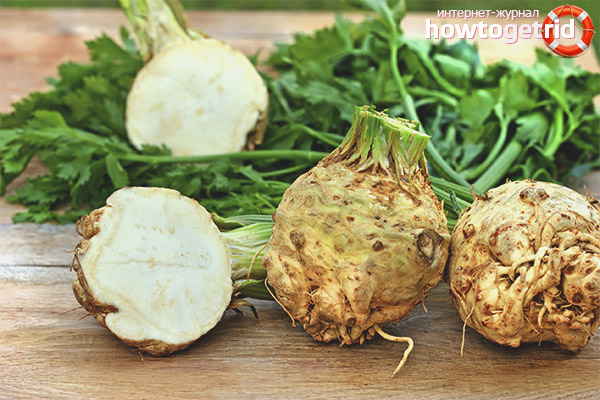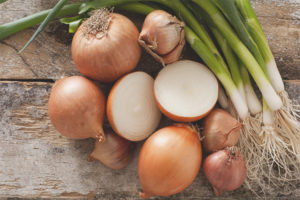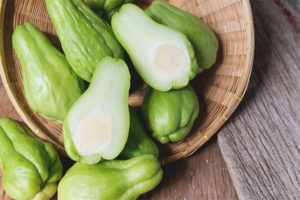The content of the article
Fragrant spicy roots and celery stalks are becoming an increasingly popular addition to dishes on our tables. The plant adds spicy notes to salads and meat recipes, enriches the dish with fiber, and also carries a lot of vitamins and healthy components for the body.
Celery has not been familiar to many since childhood, so often even those people who love food experiments and boldly buy an intricate plant do not know how to process it. There are different opinions about whether to clean celery. It is necessary to proceed from considerations of the digestibility of the product.
How to treat celery greens before eating
Celery can be divided into three components, which are eaten in different ways. Fresh herbs with a harsh ethereal aroma are added to salads and sauces, as well as meat and vegetable dishes. To do this, it is enough to rinse the greens under water, select the wilted and yellowed leaves - and send to the dish whole or finely chopped.
Chopped greens will quickly give up their juice, so the dish will quickly be saturated with the aroma of grass. Whole leaves will reveal their spice already when chewing. Therefore, choose the method of introduction to the dish, depending on the purpose. Celery is usually chopped for sauces and marinades.
How to clean celery stalks
First of all, cuttings are washed from dust and solutions that could refresh celery in a store. You can immediately divide the stems one at a time so that it is more convenient to work with the vegetable. After washing, it is necessary to cut off the dried parts along the edges, as well as remove the sinewy inclusions and films from the surface of the vegetable. They are not dangerous to the body, however, they can be bitter, and eating and digesting this part of the vegetable can be unpleasant.
The stiffness of the skin on celery stalks may depend on the degree of “ripeness” of the product, as well as on its location in the bunch. Cuttings from the inside will be more delicate than external ones, and may not require processing. Young plants are covered with a thin film, which can not be peeled off, but overgrown stems acquire more stringent protection.
To remove the film, it is enough to pry a convex vein with a knife from the edge and pull it so that the film exfoliates. You can also use a potato peeler or “housekeeper” to quickly remove the stratum corneum from the surface of the stems. After cleaning, the taste of the stems will be soft and refined.
How to Peel Celery Root
Celery roots are recommended to be cleaned without fail. The rough skin covering the root is practically not digested, has no juice, and collects all the dirt on itself. If the celery root is in front of you, it must be washed in warm water and then peeled.
To facilitate your cleaning task, try to choose a smoother vegetable with thin delicate bark while still in the store. This root will be younger, and its taste is better. At the edge of the root will be the remains of green stems. In this regard, you will be able to understand how long you have prepared the product for sale. Celery roots do not deteriorate, but if you have a choice, take a vegetable with fresh green leftovers.
Celery rind can be cut with a knife or a potato peeler - thinly and accurately. If you need a small part of the spicy root - you can immediately divide the vegetable into 2-4 parts.Those that you don’t need to cook urgently, it is better to store them in the “dressed” form in the refrigerator, then the root will remain juicy longer, and its useful and taste properties will remain until the next use. The same part that you need for the dish will be much more convenient to clean when the “edge” appears after cutting.
The peel must be cut to the thickness that becomes visible at the cut root - everything that is not juicy pulp is removed. In these parts there is no aroma and useful microcomponents. The only exceptions are dietary cases. If you appreciate the so-called negative-calorie foods - that is, those that take more energy to digest than comes from them, a sponge layer will come in handy. It is rich in fiber, will help cleanse the intestines and will be digested for a long time. There is no tasty juice in it. But for people with a sensitive stomach, it’s better not to cook this part.
Celery root is rubbed on a coarse grater with shavings for salads and stews, and for sauces a fine grater or blender is used so that the rhizome gives its fragrant juice to the base components. For side dishes, cut the root into thin slices. This product is not shredded in cubes and other large parts, since it is very stiff and has a pronounced smell. In small quantities, the aroma of celery subtly fills the dish, adding noble volumetric flavor notes to it.
They do not stew the root for very long, until it becomes soft in texture and acquires a light brown nutty hue.
For proper storage of incised celery roots there is a chef's secret: if you pour the flesh with water, the fruit will not darken. Do not store open roots in the refrigerator for long. Like other vegetables, such a product will dry out, wither and lose its beneficial nutritional properties.
Video: how to clean celery











Submit